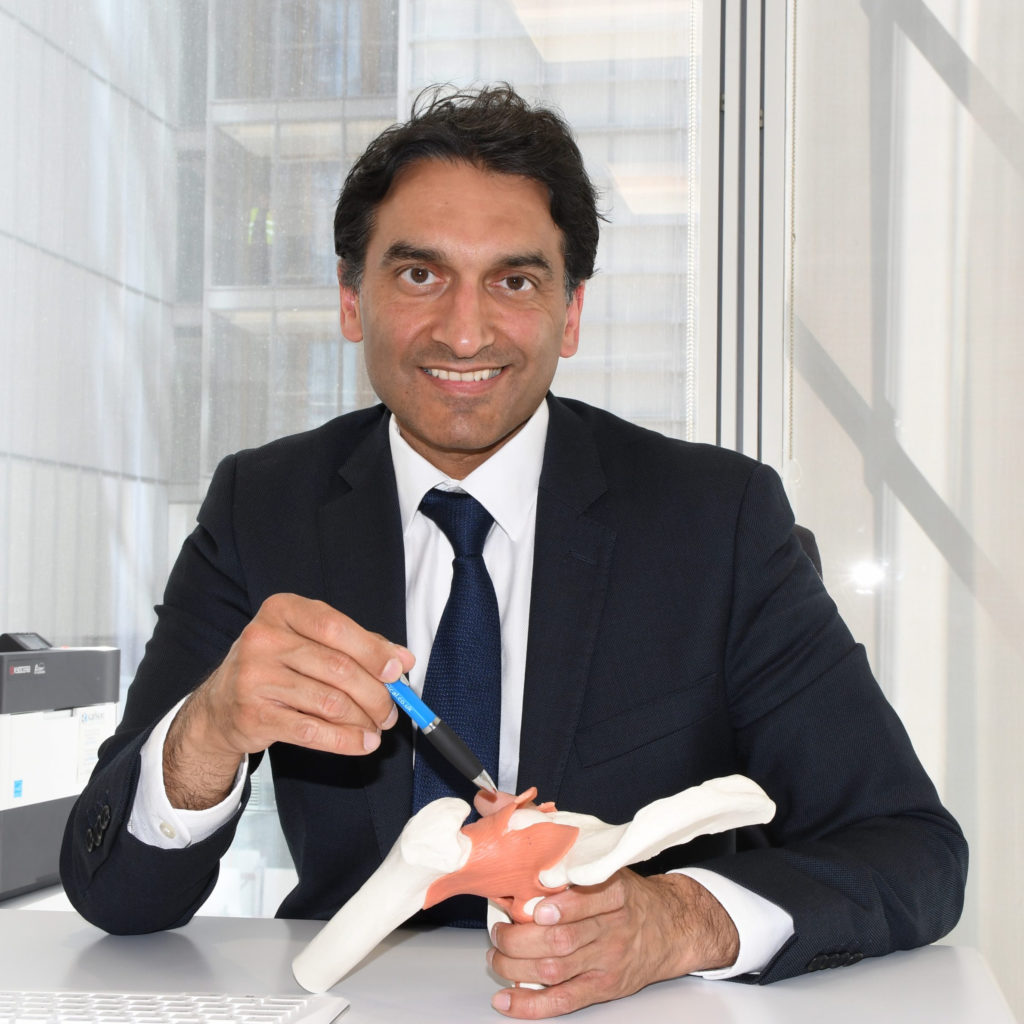
Know your Knee:
Knee surgery for ARTHRITIS
by Mr Vipin Asopa, Consultant Hip & Knee Surgeon
November 2022
Degenerative joint disease or arthritis (also known as osteoarthritis) is a very common condition. It affects approximately 8.5 million people in the UK [Versus Arthritis]. It “can affect any joint in the body. It’s most likely to affect the joints that bear most of our weight, such as the knees and feet. Joints that we use a lot in everyday life, such as the joints of the hand, are also commonly affected” [Versus Arthritis]. Osteoarthritis is often thought of as ‘wear and tear’.
Osteoarthritis of the hip is also common and can affect either one or both hips. The hip joint is a ball-and-socket joint which normally has a wide range of movement and bears a significant amount of body weight. In osteoarthritis, the joint becomes stiff and hurts when it is moved. Hip osteoarthritis is equally common in men and women [Versus Arthritis].
In this blog I explore osteoarthritis of the knee, one of the most common joints affected by osteoarthritis. “This is probably because your knee has to take extreme stresses, twists and turns as well as bearing your body weight.” [Versus Arthritis].
Osteoarthritis related degenerative changes within the knee joint involve different structures within the knee. The articular cartilage lining the surface of the bone can be thought of like the non-stick layer of a frying pan when functioning normally. In osteoarthritis, this cartilage layer gets damaged. In severe arthritis, the cartilage can disappear leaving only bone visible. Other changes can occur in damaged joints, including the formation of extra bone (called osteophytes) and hardening of the bone surfaces. The knee joint can also become swollen in response to the damage. All of these changes can cause the knee to gradually become stiff so that there is difficulty bending (flexing) the knee. [https://en.wikipedia.org/wiki/Osteoarthritis]
In the knee joint, the damage can involve the joint surface between the tibia and femur or between the femur (trochlear groove) and patella.
Risk factors for osteoarthritis include increasing age, infection and inflammation. Genetic factors and family history may be important. A previous history of trauma (for example, leading to anterior cruciate ligament injury) or participation in certain sports may be linked to an increased risk of osteoarthritis (discussed in this systematic review: https://www.ncbi.nlm.nih.gov/pmc/articles/PMC5488840/).
20.3 million
The approximate number of people who have a musculoskeletal (MSK) condition in the UK.
8.5 million
The approximate number of people who have osteoarthritis in the UK.
123,690
The number of knee replacements that were carried out in the UK in 2019.*
Treating arthritis
I specialise in the treatment of degenerative arthritis or osteoarthritis. There are varying degrees of arthritis and therefore the treatment options will vary dependent on an individual and the level of pain they are experiencing. Treatment can be anything from doing nothing to having knee replacement surgery. In most cases of early osteoarthritis, you won’t need to do anything.
Simple painkillers and topical preparations can help. Acupuncture and cold or heat compresses may also be beneficial. Maintaining an ideal body weight can help with symptoms [https://onlinelibrary.wiley.com/doi/10.1002/acr.24131].
It could be the case that you are noticing particular activities are setting off your arthritis pain. This could be anything from playing sport, walking long distances or general chores around the house that are becoming increasingly difficult. Modifying these activities can help reduce the pain that is caused. For example, if running was affecting someone’s arthritis in the knee, they may decide that going for a more gentle jog or long distance walking is a better option for them to reduce the pain.
When seeing a specialist, they may suggest the option of injection therapy. Different types of injection treatment exist. These include steroid injections, viscosupplementation and platelet rich plasma [https://orthoinfo.aaos.org/en/treatment/viscosupplementation-treatment-for-knee-arthritis/]. Some specialists also offer stem-cell based treatments. Careful scientific evaluation should be undertaken before considering this option [https://pubmed.ncbi.nlm.nih.gov/36209438/].
Your specialist may suggest physiotherapy, as this can help with strengthening the muscles and stabilising the ‘arthritic joint.’ Physiotherapy will not reverse degenerative change.
Knee replacement surgery is considered when your quality of life is significantly limited by the arthritis and other treatment options have failed. You may consider having knee replacement surgery if:
- You are experiencing significant pain
- You have pain that wakes you up at night
- A walking stick is needed to get around
- You are unable to perform many of your regular day to day activities
- It is affecting your quality of life and your ability to do the things that you would usually do.
Deciding to have knee replacement surgery
Balancing the risks of surgery against this list of considerations may help you to decide whether you want to go ahead with a knee replacement. The risks associated with knee replacement surgery include infection, blood clots (DVT/PE), pain and stiffness, failure of operation, damage to nerves (leading to temporary or permanent numbness and weakness in the leg) and blood vessels injury. Death is a rare complication. A comprehensive review of complications related to knee surgery has been published here: https://doi.org/10.1016/j.mporth.2019.10.004.

ABOUT THE AUTHOR
Mr Vipin Asopa, PhD, FRCS (Tr & Orth), MBChB, BSc (hons)
Mr Asopa is a Specialist Consultant Hip and Knee Surgeon in London, with a particular focus on hip pain, knee pain and sports injuries. Mr Asopa performs numerous surgical procedures including hip and knee joint replacements, arthroscopy as well as treating arthritis, ligament injuries, trochanteric pain and more.
To book an appointment with Mr Asopa:
Call: +44 (0) 794 319 1592 | Email: admin@ortho-surgery.uk
*Stats collected from Versus Arthritis